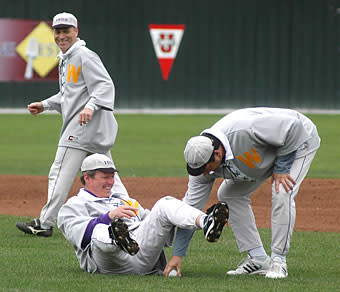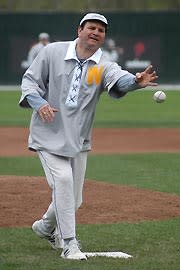Amherst and Williams re-enact first college game

Sean Logan is standing and smiling, Mike Barbera is picking up the ball and Tinker Connolly is on his keister. All are on the Williams College team during the 150th anniversary game.
(Kris Dufour/Williams College)
PITTSFIELD, Mass. – Dressed for the occasion? How often do you see a baseball coach in top hat and tails?
"This is my first time,'' Jim Briggs, the Williams man, said gleefully. "As I told my players this morning, 'If I'd worn this all the time, we would have been undefeated.' ''
Rich Thompson, the Amherst man, pitched in the big leagues for the Indians and Expos. But he could never have survived, he said, like this, standing just 35 feet away from a batter – called a "striker" – who told him where to lay the ball in, high or low, and underhanded, no less.
"Any major league pitcher throwing it where a hitter wants it,'' said Thompson, now a lawyer on Long Island, "would be out of a job, fast.''
Dan Duquette, the former general manager of the Boston Red Sox, is an Amherst man. George Steinbrenner, the former owner of the New York Yankees, is a Williams man. Each year, Duquette said, the two men made a wager, one that had nothing to do with who would be playing in the World Series that summer.
"We used to bet 20 bucks on the Amherst-Williams football game,'' Duquette said. "Williams beat us every year but one, in all the years that we bet.
"I'm still waiting to get paid, though.''
No word on how much action there was on Sunday's Amherst-Williams chess match, held in a white tent just outside the entrance to 117-year-old Wahconah Park, the creaking but still breathing edifice in which alumni of Amherst and Williams, two ancient rivals on the fields of academe and athletics, staged a re-enactment of the first college baseball game ever played, in its 150th anniversary year. They played chess that day – July 1, 1859 – too.

Mike Barbera graduated from Williams College in 1989.
(Kris Dufour/Williams College)
The game played Sunday bore only passing resemblance to the baseball we know today. It took place on a square, not a diamond. There were no bases, just four-foot stakes at the four corners of the inner field. The striker stood in a circle halfway down the first-base line, and could hit the ball from the "thrower" in any direction, including behind him. There was no such thing as a foul ball. Everything was in play, which is why hitters soon took aim at the bleachers.
No gloves were used, a ball had to be caught in the air to be an out, although a striker could be retired by being hit by the ball thrown by a fielder, such a play called a "soaking." The umpire was known as the referee, and he, too, wore a tux. There was only one out per side per inning.
The sides placed a 45-minute time limit on the game, but back in the day victory used to require the scoring of 100 runs. Amherst won the first meeting, 73-32, in a game that went 25 innings.
"This was the right thing to do,'' said Duquette, a driving force behind this re-enactment, along with a Williams man, Michael Barbera (class of '89), a Washington lobbyist.
"You know, some historians say they were playing baseball in Pittsfield in 1791,'' said Duquette, alluding to the discovery of a document in 2004 in which a town bylaw mentions baseball, the earliest known reference to the game in the United States.
"But there is no disputing that Amherst and Williams played the first college game. You'll drive right by St. Joseph's Church, on the corner of North and Maplewood. That's where they played the first game, where the church is now."
Amherst and Williams are located only a handful of miles apart in western Massachusetts, Amherst in a town of the same name, Williams in Williamstown. Williams came first, in 1793. Williams teams are known as the "Ephs'' after the name of the school's benefactor, Col. Ephraim Williams, who had left money for a school before being killed in the French and Indian War almost 40 years earlier. A president of Williams, Zephaniah Swift Moore, resigned and moved with some faculty members to Amherst, where he started that school in 1821 ("We're sure he took some of our library books, too,'' Briggs said).

Amherst manager John Couture and Williams manager Jim Briggs donned top hats and tails.
(Kris Dufour/Williams College)
"These schools were birthed from the same spot,'' said Kevin Morris, who pitched and played quarterback for Williams (Class of '86) and recently was named football coach at the University of Massachusetts. "They have history from day one. Nothing is fabricated or artificial, this is a situation where you're talking about two real nemeses. That's your rivalry.''
Amherst and Williams are both recognized as academic powerhouses.
"Both schools, you knew the students were all going to be doctors and lawyers and Presidents of the United States,'' said Briggs, whose boast wasn't hollow – Calvin Coolidge was an Amherst man, James Garfield a Williams man, and both schools have lists of alumni that are all-stars in just about every field imaginable.
But both schools also have had heavyweight connections to baseball. Amherst has sent 14 players to the big leagues, the most notable probably being pitcher John Cerutti, who was drafted in the first round by the Blue Jays in 1981 and pitched seven seasons in the big leagues. Duquette got his first job in pro ball from Brewers GM Harry Dalton, an Amherst man. One of his Amherst teammates, Dave Jauss, is bench coach for the Baltimore Orioles, while Ben Cherington, the Red Sox senior VP and assistant GM, is another Amherst man.
Williams has had nine big leaguers, the last, a pitcher, Mark Filley, in 1934. But their roll also includes Steinbrenner, former commissioner Fay Vincent, who played football at Williams until one of his legs was crushed in a campus accident, and Bob Nutting, the new owner of the Pittsburgh Pirates, who was in attendance Sunday.

Chess was played Sunday, as it was on the day of the first college baseball game 150 years ago.
(Kris Dufour/Williams College)
Duquette smiled when asked to compare the Amherst-Williams rivalry to Red Sox-Yankees. "I'd say it was more genteel,'' he said.
Briggs comes from an enviable baseball pedigree. His grandfather was Walter O. Briggs, who bought the Detroit Tigers in the '30s (until 1960, the Detroit ballpark was called Briggs Stadium). "Daddy took over the team in the late '40s,'' said Briggs, who remembers throwing batting practice to a teenaged Al Kaline.
Briggs was a junior second baseman at Williams in 1959, when the schools staged their first re-enactment of the inaugural game. Ford Frick, the MLB commissioner, and Joe Cronin, the president of the American League, were at that one, which was played at Amherst.
In 1976, Briggs was Williams coach when they held their second re-enactment as part of bicentennial ceremonies in Pittsfield, with Hall of Famer Lefty Gomez in attendance and 5,000 fans packed in Wahconah Park.
The third re-enactment Sunday was a more modest affair, with the stands filled mostly with family, faculty, and alums, who listened as a proclamation from commissioner Bud Selig hailing the anniversary was read.
Williams won the re-enactment – they've won all three – and their chess team won, too, a reversal of the original outcome, which was quite the upset, according to press reports of the day. "In Ball-playing it was generally thought Amherst would win,'' the Adams Transcript wrote. "But no one expected the victory for her in chess.''
Later Sunday, the Williams varsity beat Amherst, 8-5, knocking the Lord Jeffs out of the playoffs and ending the career of Amherst's legendary coach, Bill Thurston, who ran the program for 44 years.
"That's unbelievable – three generations,'' Duquette said. "I owe my living to Bill Thurston.''
Jim Briggs was already looking forward to the next re-enactment. "That'll be in 50 years,'' he said. "I'll be 122 then. I told my players I'd be there, and they'd better be there, too.''
